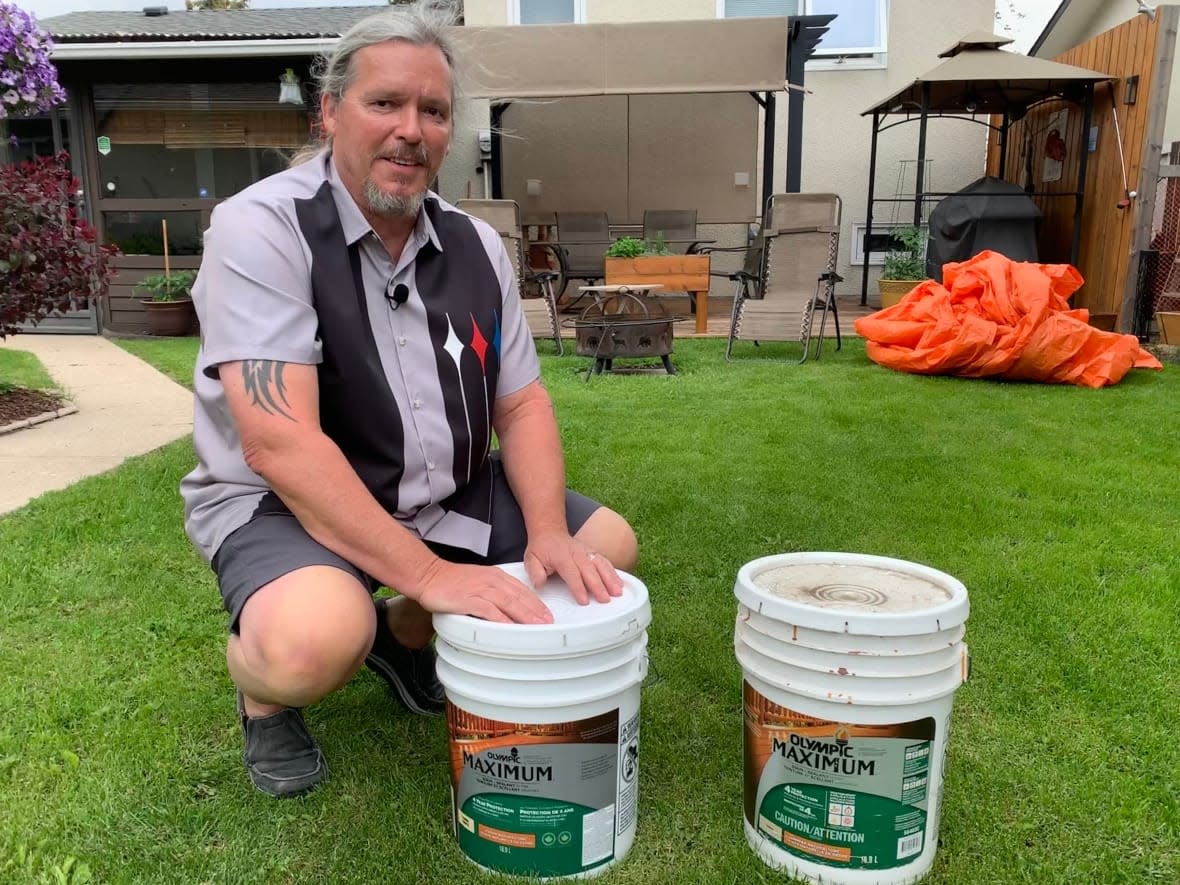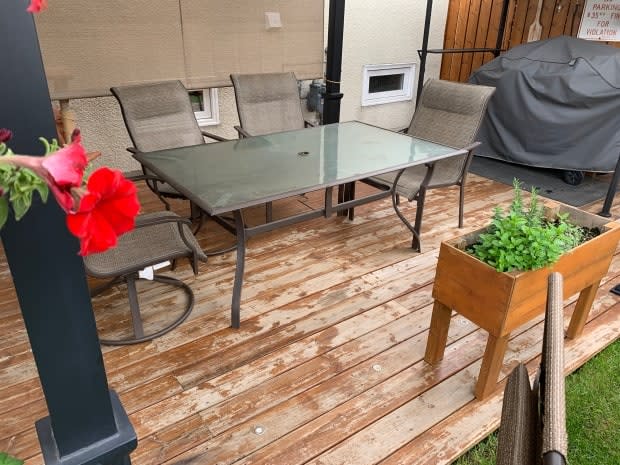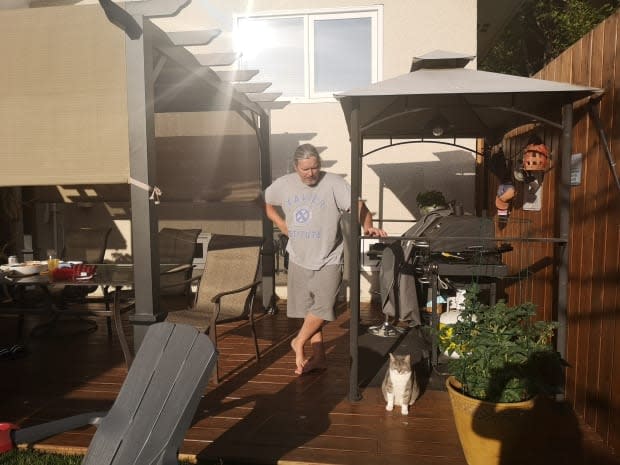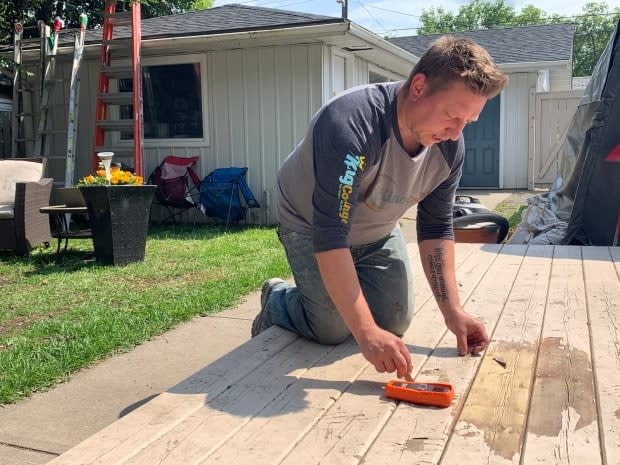Deck stain companies promise 4-year guarantees. Why do so many not hold up?

Andreas Mann spent a week of vacation time painstakingly prepping and staining his deck in north Edmonton two years ago.
He used a product that came with a four-year guarantee, so he was surprised this fall when he noticed that flakes of the stain were already coming off. By spring, large chunks were gone and it was clear the deck would need to be re-stained.
"It's devastating because it's not just the paint and the money, which you're putting in — it's your free time, it's your labour, it's your sweat," Mann said.
Mann complained to the store from which he bought the stain and the company that makes it. The manufacturer offered him some compensation, but he refused to sign a release form that included a confidentiality clause.
Many deck stain companies say their products will last for four years or longer, but many Canadians see their stains peel prematurely.
Multiple professional painters told CBC News that stains can last three to four years, but only if wood is properly prepared and the stain is applied at the right time.

'It's not about the money'
Mann trained as a professional painter in Germany, so he knew the steps he should take before and after staining his deck.
After washing the pressure-treated wood, he let it dry for several days before sanding it down with two types of sandpaper. His wife used a vacuum to ensure all of the dust and debris was gone before painting.
Mann applied two coats of Olympic Maximum Stain + Sealant, since one didn't sit well on the wood, he said.
In the following months, he protected his deck from the elements. He wiped off water if there was excessive rain, and swept off snow with a broom to avoid scraping the stain with a shovel.
After discovering the extent of the stain damage this spring, Mann complained to the Lowe's store where he had bought the product.
Through Lowe's, a representative for the stain manufacturing company, PPG, got in touch with Mann. After some back and forth, the company offered to reimburse him for the bucket of the stain he used, as well as money to cover a paint stripper, cleaner and a bucket of a different stain.

Before receiving a cheque, however, Mann was asked to sign a release form, which he shared with CBC News.
The form said PPG Canada would pay Mann $485.46, not as "an admission of any liability" but "to settle the claim on an amicable basis, to avoid litigation."
Both parties would accept to preserve the "highly confidential" character of the agreement and to refrain from sharing it with anyone, it stated.
Mann said he did not sign the form because he wanted to share his experience so others could learn from it.
"It's not about the money anymore," he said.
Mann was also frustrated by some of the suggestions from PPG: that he should have only used one coat of stain, that his ground-level deck didn't have enough room for air flow underneath and that the proper way to stain his deck would be painting all six sides of the wood.
He wished the company had sent someone to his home to inspect the deck in person and compensated him for his labour.
Company stands by stain
The stain Mann used is satisfaction-guaranteed for four years on decks when it has been applied and maintained according to the label directions, said Mark Silvey, PPG's director of corporate communications, in a statement via email.
The application directions say consumers should paint when no rain is expected for eight hours, and when the temperature is at least 2 C and will stay warmer than that for 24 hours, the instructions say.
Consumers should also apply one thin coat and avoid staining in direct sunlight, they add.
Silvey said the company's technical services team is available by phone to help customers with questions.
How to prevent premature peeling
Two Red Seal journeyman painters in Edmonton told CBC News that deck stain should last three to four years, but many homeowners see it fail sooner because of insufficient prep work, staining at the wrong time or using the wrong products.
David Ebert of King Coatings said preparation is the most important part of the staining process.

He uses a moisture reader to make sure wood is dry enough to stain — containing between 12 and 15 per cent moisture — and he doesn't like pressure-washing because it tends to force water into the wood.
If pressure-washing first, Ebert recommends leaving the deck to dry for four days.
After sanding — usually first with 60-grit paper, then 120-grit paper — he either vacuums up dust, or uses a compressor and air gun to blow away debris.
Ebert recommends applying stain when the temperature is between 15 and 24 degrees and, ideally, not in direct sunlight.
"If the wood isn't dry enough and people are doing it in the hot sun, that also causes the stain to evaporate a little quicker," he said.
Mike Pratt of Precision Cut Painting recommends researching stains and picking one of good-quality with positive reviews.
He also suggests using a staining brush — not a regular painting brush — and reading all the instructions on the stain's label.
The label on the stain Mann used said it could be applied eight hours after rainfall, but both Ebert and Pratt recommend waiting longer for wood to fully dry out before painting.
Ebert said cedar tends to hold up better than pressure-treated wood and that, on Edmonton decks, oil-based stains seem to last longer than those that are water-based.
His final recommendation: use a tarp to protect the deck from moisture during the winter.
"It gives it a much longer longevity," he said.


